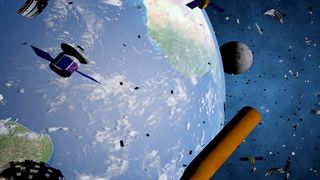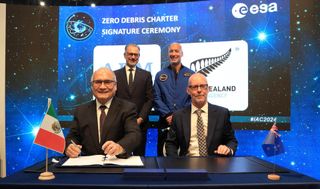Fighting space junk: More than 100 partners sign Europe's 'Zero Debris Charter'
Twenty-four partners signed at this month's International Astronautical Congress in Milan.

The European Space Agency (ESA) is making strides in its efforts to boost space safety and sustainability.
ESA is promoting the Zero Debris Charter, which aims to increase international efforts and cooperation to solve Earth's growing space junk problem. And the agency now has attracted well over 100 signatories to the charter, following a ceremony at the International Astronautical Congress (IAC) in Milan, Italy, on Oct. 14.
New Zealand and Mexico were among the 24 new signatories at the IAC, becoming the first countries from outside Europe to sign the charter.
"The Zero Debris Charter signals Europe’s unwavering commitment to be a world leader in reducing and remediating space debris, fostering collective action by a large community of space actors around the world," said Salvador Landeros Ayala, general director at the Mexican Space Agency.
Related: 7 wild ideas to clean up space junk
"We place a lot of importance on space sustainability in New Zealand, and ESA’s Zero Debris Charter aligns well with our values," said Iain Cossar, head of the New Zealand Space Agency.
The Zero Debris Charter was published in November 2023. It is not an ESA charter, but represents a collaborative effort within the global space community and serves as a foundational document. The charter sets out goals and guiding principles, and these are to be developed collaboratively into actionable and measurable targets.
Get the Space.com Newsletter
Breaking space news, the latest updates on rocket launches, skywatching events and more!

Guiding principles include that space debris should not be intentional, adverse effects should be anticipated and mitigated to the greatest extent possible, and constant and collaborative efforts should be made to understand the problem. Jointly defined targets include removing spacecraft from orbit in a timely manner at end of mission, safe reentry practices and data sharing.
Currently, ESA estimates that more than 1 million pieces of debris 0.4 inches (1 centimeter) in size or greater are in orbit around Earth, posing a threat to space operations, whether human spaceflight, commercial activities, science or other missions.
"I think it's beautiful that, in a change of paradigm, a big leap of imagination made us decide to have a volunteer charter," Luca Parmitano, ESA astronaut, said at the ceremony. "It's everybody saying: We think this is important, and we want to do something about it, not only for the future, but even now. We want to act. We want to be an active part of cleaning up space."
The total number of signatories is 15 countries and over 100 companies, research centers and international organizations, with many more having stated their intent to follow suit, ESA said in a statement.
ESA Director-General Josef Aschbacher stressed the importance of sustainability in space at the event, highlighting it as a major priority since becoming the new ESA head.
"I'm, honestly speaking, amazed, surprised and impressed, how many people have been signing up to this charter on a voluntary basis," Aschbacher said. "We are a space agency, we are not a regulatory body. We will not enforce it. We will not bring you to court if you don't, if you don't adhere to the principles."
"It's a moral commitment, and this moral commitment is so strong and it's so important that voluntarily, many people have decided to sign up, countries as well as companies, individual organizations, governmental organizations, nongovernmental organizations," said Aschbacher.
Other new signatories on Oct. 14 include a range of institutions, such as the Australian National University Institute for Space, Alpha Impulsion and ARCA Dynamics and Intella.
The charter aims to ensure that space remains clean and safe for future generations, and new technologies will need to be developed to help achieve what ESA describes as realistic-yet-ambitious targets.
Join our Space Forums to keep talking space on the latest missions, night sky and more! And if you have a news tip, correction or comment, let us know at: community@space.com.

Andrew is a freelance space journalist with a focus on reporting on China's rapidly growing space sector. He began writing for Space.com in 2019 and writes for SpaceNews, IEEE Spectrum, National Geographic, Sky & Telescope, New Scientist and others. Andrew first caught the space bug when, as a youngster, he saw Voyager images of other worlds in our solar system for the first time. Away from space, Andrew enjoys trail running in the forests of Finland. You can follow him on Twitter @AJ_FI.